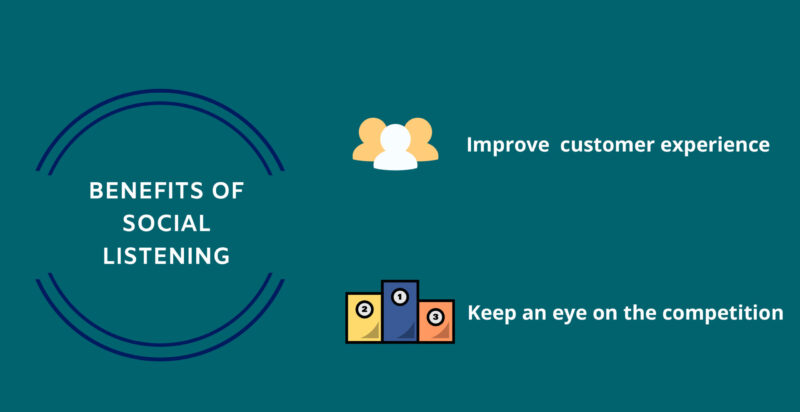In the modern era of technology, social media has become a crucial means for companies to engage with their clientele and promote their goods or services. Merely publishing content and relying on chance is insufficient. To truly leverage the power of social media, businesses need to actively listen to what their customers are saying and adapt their strategies accordingly. This is where listening social media comes in.
Social listening refers to the practice of keeping track of your brand, products, competitors, and industry-related keywords by monitoring social media platforms. By analyzing this data, businesses can gain valuable insights into their customers’ needs, preferences, and pain points. In this article, we’ll explore the benefits of social listening and provide tips on how to effectively use it for your business.
Understanding The Benefits Of Listening Social Media

One of the primary benefits of listening social media is the ability to gain a deeper understanding of your customers. By analyzing their conversations and feedback on social media, you can identify common themes and trends.
Setting Up A Social Listening Strategy

To effectively use social listening, you need to have a clear strategy in place. Here are some tips to get started:
- Define your goals: What do you hope to achieve through social listening? Are you looking to improve customer satisfaction, monitor your brand’s reputation, or gather market research data? Clearly define your objectives before diving into the data.
- Choose your tools: There are a variety of social listening tools available, from free options like Google Alerts and Twitter Advanced Search to paid tools like Hootsuite and AIM Insights. Select the tools that are most suitable for your requirements.
- Identify keywords and topics: What keywords and topics are relevant to your business? These could include your brand name, product name, industry-related keywords, and competitor names. Use these keywords to create custom searches within your social listening tools.
- Monitor your results: Set up alerts or notifications to stay on top of any mentions of your brand or keywords. Monitor the data regularly to identify any trends or insights.
Using Listening Social Media To Improve Your Business

Once you have your listening social media strategy in place, it’s time to start analyzing the data and using it to improve your business. Here are some ways to do this:
- Improve customer service: By monitoring social media for customer complaints or issues, you can quickly respond and resolve any problems. This can aid in enhancing customer satisfaction and loyalty.
- Develop new products or services: Use social listening data to identify customer needs and pain points. Use this information to develop new products or services that meet those needs.
- Create targeted marketing campaigns: Use social listening data to create more targeted marketing campaigns that resonate with your target audience.
- Monitor your brand’s reputation: Social listening can help you quickly identify and respond to any negative feedback about your brand. This can help protect your brand’s reputation and maintain customer trust.
Case Studies with Record Breaking Results
1. Starbucks: Mastering Customer Engagement
Starbucks has consistently proven how social listening can fuel remarkable success. By leveraging social media listening tools, Starbucks was able to track customer sentiment, product mentions, and feedback. In 2020, they noticed a growing trend of customers asking for plant-based milk options, particularly oat milk. By tapping into these conversations, Starbucks was able to roll out oat milk as an official menu item, which became a hit worldwide.
The result? A record-breaking 30% increase in customer engagement and a significant boost in sales for their coffee drinks made with plant-based alternatives. This rapid response to consumer demand helped Starbucks maintain its position as an industry leader in the food and beverage sector.
2. Nike: Driving Record-Breaking Sales with Real-Time Feedback
Nike’s success with social listening has been nothing short of legendary. The global sportswear giant used social listening tools to closely monitor consumer conversations during the launch of their Nike Air Max 270 React. Consumers were vocal on platforms like Twitter and Instagram, sharing both positive feedback and constructive criticism. Nike used this data to improve the customer experience, quickly addressing concerns about sizing issues and enhancing marketing campaigns in real-time.
As a result of these efforts, Nike achieved record-breaking sales figures, surpassing $10 billion in quarterly revenue in 2021. The company’s ability to tap into customer insights and adjust its marketing strategy immediately helped them stay relevant in a competitive market.
3. Netflix: Using Social Listening to Revolutionize Content Strategy
Netflix’s approach to content creation and customer retention also benefited greatly from social listening. By monitoring online discussions and hashtags related to their original content, Netflix was able to gain insights into what genres, actors, and plotlines resonated most with their audience.
In one memorable case, Netflix discovered an enormous demand for true crime documentaries through listening to social media chatter. Based on this insight, Netflix launched Making a Murderer, which became one of their most-watched series at the time. This strategy not only boosted subscriber growth but also drove Netflix’s global expansion, with subscriber numbers surpassing 200 million in just a few years.
4. Wendy’s: Leveraging Social Listening for Brand Positioning
Wendy’s social media strategy is a textbook example of how brands can use social listening to engage customers in real-time. Known for their humorous, sometimes edgy Twitter posts, Wendy’s actively listens to customer feedback and competitor activity to engage in witty, timely, and often viral exchanges.
In 2017, Wendy’s noticed a trend of consumers complaining about fast food chains’ lack of fresh beef. By tapping into this conversation, they launched a campaign around their 100% fresh, never frozen beef and engaged directly with customers who were voicing their concerns. The result? A 28% increase in Twitter followers and record-breaking sales for the company, making Wendy’s the most talked about fast food brand of the year.
Conclusion
In conclusion, listening social media can be a game-changer for businesses looking to stay ahead of the competition and better serve their customers.
If you’re ready to take your social listening strategy to the next level, contact AIM Technologies today to request a demo of our powerful social listening platform. Our team of experts can help you harness the power of social media data to make better business decisions and drive success.




